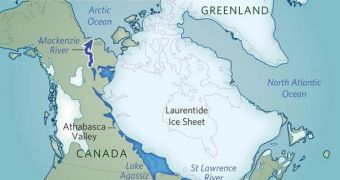Geologists are very familiar with the Younger Dryas period, which occurred some 13,000 ears ago. It's not like something out of this world happened at this point, but geological records would seem to indicate that, just as the planet was exiting the last ice age, a new cold spell lasting several millennia struck the Northern Hemisphere. This apparently happened out of the blue, but scientists have been proposing for a long time that a flood of meltwater from glaciers in the Canadian Arctic might be to blame for this. However, until recently, they had no conclusive evidence to back up their claims.
A short while ago, while browsing through a dataset collected from Canada's Mackenzie River, researchers were surprised to discover what they think are traces of the hypothesized flood. But, very much to their amazement, they found that the meltwater did not flow into the Atlantic Ocean, as believed, but rather in the Arctic Ocean. They say that this actually makes more sense, seeing how this vast volume of cool water may have disrupted the warming currents of the northern waters faster and more efficiently than they could have acted in the Atlantic, Nature News reports.
However, the team says that the influence the flood had was eventually felt in the Atlantic as well. It basically disrupted the global warming trend all around the globe. When the younger Dryas began, global temperatures dropped by 10 degrees Celsius, on average, within only a few decades. Though the theory which states that cool water flowed in the North Atlantic and stopped the Conveyor Belt there is widely accepted in the international scientific community, researchers never discovered the hypothesized signs of the running water, which would have backed up their claims.
The investigators, which were led by University of Sussex in Brighton expert Julian Murton, found that the water actually melted in the Arctic Ocean via the Mackenzie River and not in the Atlantic via the St Lawrence river, as initially suggested. The group says that, if the Laurentide Ice Sheet – the source of the meltwater – would have laid just slightly east of the location researchers proposed it occupied, then several thousand cubic kilometers of water could have easily flooded the Northern Ocean. “Geomorphic observations and chronology clearly indicate a northwestern flood route down the Mackenzie valley,” concludes University of Manitoba in Winnipeg geologist James Teller.

 14 DAY TRIAL //
14 DAY TRIAL //